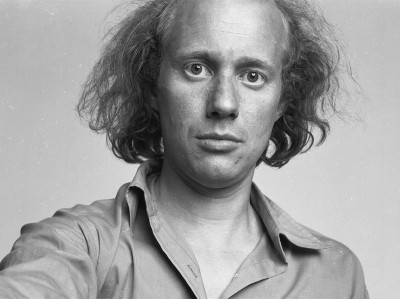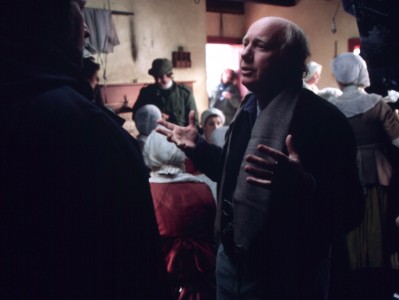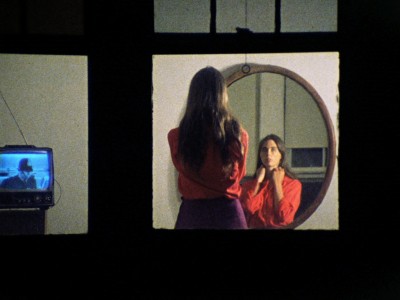
Documentary filmmaker and Harvard professor Richard P. Rogers (1944–2001) studied photography as an undergraduate at Harvard and made his first films there in the 1970s. After graduating, he directed documentaries for public television and taught at SUNY Purchase for many years. In the 1990s Rogers returned to Harvard to teach filmmaking and serve as the director of the Film Study Center.
Beyond filmmaking, Rogers’ eclectic interests—including politics, art and psychology—are reflected in the diversity of the films he made, from portraits of writers and filmmakers to explorations of the aftermath of the Nicaraguan revolution. His lifelong interest in the arts—whether in the form of painting, poetry or cinema—led him to create several unique portraits of artists and writers. He followed filmmaker Jan Lenica making an animated film on Harvard’s Oxberry in Moving Pictures (1975) and in Voices and Visions: William Carlos Williams, (1988), Rogers constructs an endearing portrait of the poet and physician.
Sometimes his documentary visions veered toward the experimental, as in Quarry (1970), a poetic essay of the daily rituals of young men and women hanging out on the perimeter of the Quincy Quarry, diving, smoking and sunbathing during the early days of the Vietnam war.
Elephants (1973) is a personal examination of the director’s family intercut with his love affairs and the recurring image of elephants caged in a zoo. In 226-1690 (1984), he takes the audience into his New York neighborhood and his circle of friends and family via his answering machine messages over the course of a year. From the vantage point of the filmmaker’s New York apartment window, weddings take place in the church across the street, passersby struggle through the snow on the sidewalk, and we gradually become submerged in the meditative rhythms of Rogers’ interior world.
He documented the complicated gentrification of Boston's South End in Neighbors: Conservation in a Changing Community (1977) and in 1979 made The Cost of Living, a documentary in which he interviews a Boston fireman, a wealthy Boston businessman and a mixed race family, recording their responses to questions related to the meaning of money in their lives. These works and many that followed reflect Rogers’ continuing interest in issues of economics and class in American life. William Kennedy’s Albany, made for television in 1992, is more than a portrait of an American author. While following the Pulitzer Prize-winning novelist William Kennedy (Billy Phelan's Greatest Game, Ironweed) through Albany's neighborhoods, he shows us a multi-ethnic city still experiencing the effects of urban decline and poverty.
The documentaries Living at Risk: The Story of a Nicaraguan Family (1985) and Pictures from a Revolution (1991), made with Susan Meiselas and Alfred Guzzetti, were off-shoots of Meiselas' photographic project that became the iconic book Nicaragua: June 1978-July 1979. Following Rogers', Meiselas' and Guzzetti's attempts to track down the individuals pictured in her book, Pictures from a Revolution is a meditation on the meaning of photography as well as a melancholic journey through the broken dreams of the Sandinista revolutionaries.
In one of his last films, Rogers worked with writer Laurie Kahn to adapt Laurel Thatcher Ulrich’s Pulitzer Prize winning book, A Midwife’s Tale, into a feature-length film for PBS’ American Experience. Ulrich’s book featured the actual diary of an ordinary woman, Martha Ballard, to tell a socioeconomic history of rural life in New England and the everyday struggle, violence and mundanity of women’s lives in the late 18th and early 19th centuries. Combining elements of documentary and fiction, the filmmakers not only bring Martha Ballard to life, but also illustrate the often hidden labor of historical research by showing Ulrich herself performing the detailed and expansive detective work of interpreting Ballard’s life through the document she has left behind.
Richard Rogers' intimate history of America would culminate posthumously with former student Alexander Olch's documentary The Windmill Movie (2001) which creatively assembles footage Rogers had collected for an autobiographical film that had remained unfinished upon his death.
ABOUT THE COLLECTION
Donated to the Harvard Film Archive in 2003 by the late filmmaker’s wife, photojournalist Susan Meiselas, the Richard Rogers collection contains film prints, negatives and other elements—including outtakes—of fourteen of Rogers' films. The collection is catalogued in Hollis.
ADDITIONAL RESOURCES
Some of Rogers' works are distributed by Documentary Educational Resources. Pictures from a Revolution is indepdently distributed. Robert Gardner's interview with the filmmaker, Screening Room with Richard Rogers is available via Kanopy or DER.















